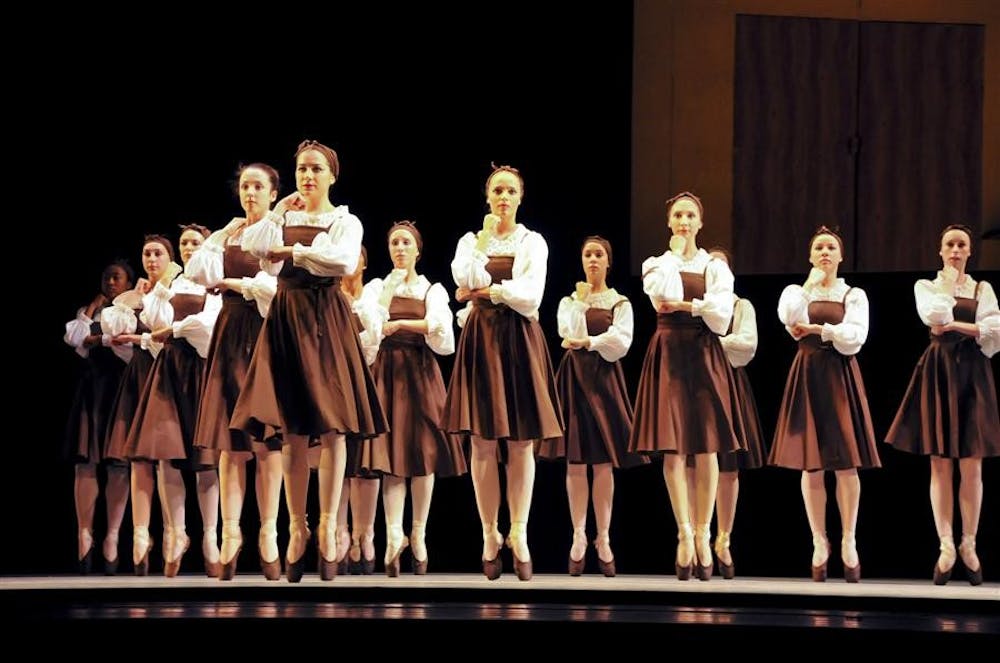Sergei Diaghilev forever changed the art of ballet in America, influencing thousands for generations to come.
Now, IU Ballet Theatre will honor the impresario with this year’s fall ballet, a tribute to his reputation to commemorate the 100th anniversary of the founding of the Ballets Russes, which brought artists like Anna Pavlova to the United States.
“It was the first time the West had seen these great Russian dancers and Russian designers and Russian choreography,” Ballet Department Chair Michael Vernon said, explaining that Diaghilev was so influential in large part because of his collaborations with other great composers, dancers and choreographers.
“He got them to do great art on stage,” he said.
Vernon said Diaghilev also inspired musicians and visual artists.
The department will present four dances from Diaghilev and his protege, George Balanchine, Vernon said. These include “Jeux,” which Vernon himself choreographed and described as more of a “danced play” about three people’s personalities and relationships, and “Les Noces,” which Vernon said is very stylized and centers on a Russian wedding.
“It’s just a wonderful work of art,” Vernon said of “Les Noces.” “It’s a masterpiece.”
Senior Heidi Satterthwaite will dance as bride and said the ballet is often less about the movement itself.
“It’s much more of an architecture-based ballet,” she said.
Audiences will also see both versions of “Valse-Fantasie” choreographed by Balanchine, one in 1953 and the other in 1967.
“Both are completely different,” Vernon said, adding that the ’53 version is neo-romantic while the ’67 ballet is neo-classic.
While neither is inferior or superior in his opinion, Vernon said the differences were a reflection of Balanchine’s changing style.
“Balanchine was very forward-thinking ... He was about visualizing the music,” Vernon said. “When he was older, he heard the music differently.”
Guest artist Howard Sayette will act as the regeisseur for “Les Noces.”
“It’s a French term meaning ‘stage director,’” he said, but in the ballet vocabulary, it refers to someone who restages a ballet choreographed by someone else.
There will be four scenes, he said – the bride’s friends preparing her, the bachelor party, the bride leaving for the ceremony and the wedding rite itself. The last is Satterthwaite’s favorite, because she said it is very intricate, with 30 “guests” dancing at once while the bride, groom and their parents look on.
“It’s a very difficult ballet to learn, but it looks so impressive,” she said.
When Stravinsky wrote the score, the original idea for staging it as a ballet was to make it a bright, colorful diversion. Bronislava Nijinska, the Ballets Russes choreographer who adapted it, had a different feeling about the bride’s emotions surrounding an arranged marriage, Sayette, who worked on that original production, said.
“It was very possible she would never see her family again,” he said. “The bride may have a happy life, but she may not.”
Even if it’s not what the composer initially intended, Satterthwaite said the dance meshes perfectly with the melody.
“It’s so well-choreographed. It goes so well with the music,” she said. “The dancing is one with the music.”
Fall play: Diaghiley Tribute
When 8 p.m. Friday and Saturday
Where Musical Arts Center
cost Student tickets range from
$8 for third balcony to $16 for center orchestra.
More Info There will be a “To
the Pointe” pre-ballet lecture at 7:00 p.m. in the Musical Arts Center Mezzanine.
Diaghilev masterpieces harmonize ballet with music

Get stories like this in your inbox
Subscribe





